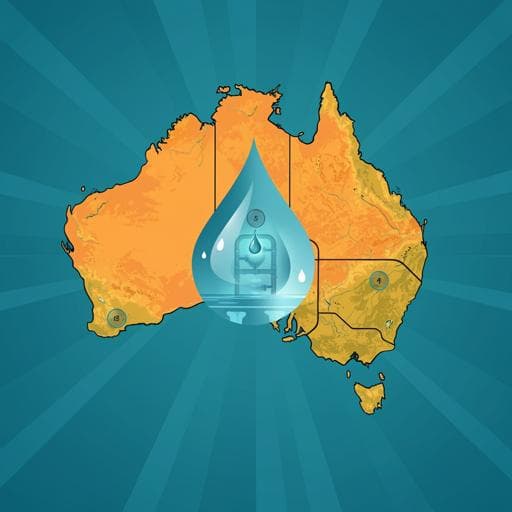
Environmental Studies and Forestry
Measuring the gaps in drinking water quality and policy across regional and remote Australia
P. R. Wyrwoll, A. Manero, et al.
This groundbreaking study, conducted by Paul R. Wyrwoll, Ana Manero, Katherine S. Taylor, Evie Rose, and R. Quentin Grafton, reveals critical gaps in drinking water quality data across regional and remote Australia, emphasizing the urgent need for targeted solutions, especially for remote Indigenous communities.
~3 min • Beginner • English
Introduction
The study investigates whether regional and remote communities in Australia have access to basic levels of safe and acceptable drinking water, and how reported outcomes differ when measured against global SDG 6.1 indicators versus the Australian Drinking Water Guidelines (ADWG). Despite strong performance in large cities and national reporting that suggests high coverage of safely managed water services, many regional and remote communities—especially remote Indigenous communities—experience poor water quality and monitoring gaps. The paper’s purpose is to assess publicly available data, identify monitoring/reporting gaps, and quantify populations and locations where drinking water quality does not meet basic levels of service defined with reference to the ADWG. The importance lies in revealing disparities between metropolitan and non-metropolitan service levels, aligning policy with locally relevant benchmarks, and informing investments and reforms to ensure safe, reliable, and acceptable drinking water for all Australians.
Literature Review
The paper situates Australia’s drinking water quality gaps within a broader international context where high-income countries nearing SDG 6.1 still face deficiencies. It references substantial government investments in the United States, Canada, and New Zealand to remediate contamination and upgrade systems. Prior audits and reports in Australia highlight fragmented monitoring/reporting outside major utilities, particularly in New South Wales, and significant gaps in remote areas (e.g., Western Australian remote Indigenous communities lacking routine testing). A body of research documents the health, socio-economic, and governance challenges in remote Indigenous communities, emphasizing historical and ongoing water injustices, high operating costs, remoteness, and barriers to collaborative management. The ADWG provides a comprehensive national framework with health-based and aesthetic values that are often stricter than WHO’s for some aesthetic parameters. This context underscores the need for locally contextualized benchmarks beyond SDG indicators and improved transparency, monitoring, and reporting to guide policy and investments.
Methodology
Design: A national review and compilation of publicly available drinking water quality data for the financial year 2018–2019 across 177 drinking water suppliers identified from the Urban National Performance Report and state/territory sources. Data gathering: Researchers searched utility websites, regulator archives, and government portals for annual drinking water quality reports. For Queensland and New South Wales (NSW), the Wayback Machine was used to retrieve unavailable reports. NSW data were limited to aggregated health compliance statistics due to lack of mandated public reporting. Data coverage: Included large state-owned utilities and small local utilities; 12 utilities serving seven capital cities were reviewed for geographic comparison. Regional/remote analysis excluded outer metropolitan areas classified as ‘Major Cities’ under the ABS Remoteness structure. Timeframe: Primarily 2018–2019; for 22 Queensland local utilities, the most recent available year (2017–2018 or 2019–2020 calendar year sampling) was used. Definitions of basic service levels: Four definitions were operationalized: (1) SDG 6.1: No exceedances against ADWG health-based values (E. coli, arsenic, fluoride) and any jurisdictional annual compliance standards; (2) ADWG Health: Compliance with all ADWG health-based values across microbial (E. coli), chemical (212 parameters), and radiological quality, considering jurisdictional compliance targets; (3) ADWG Good: ADWG Health plus mean annual values for six aesthetic physical characteristics (true colour, turbidity, hardness, total dissolved solids, pH, dissolved oxygen) not exceeding ADWG aesthetic values; (4) Metropolitan: ADWG Good plus mean annual values for 25 aesthetic-related chemical parameters not exceeding the higher of the ADWG aesthetic value or the highest mean value in the corresponding capital city. Recording exceedances: For each location (water supply zone or smallest reported unit), the team recorded averages, maxima, 95th percentiles, and/or counts/percentages of exceedances where parameters failed to comply with ADWG health or aesthetic values, following ADWG rounding. Health non-compliance is triggered by any exceedance (excluding verified false positives); aesthetic non-compliance relates to mean annual values. Documented false positives, potential data entry errors, or exceedances not breaching jurisdictional annual targets were flagged and excluded from service level failure counts. Population matching: For each location with exceedances, population was estimated using a hierarchy: (i) utility-provided values; (ii) ABS 2016 Census (Urban Centre and Locality, then State Suburb, then Indigenous Locations); (iii) government sources for remote communities. Limitations of statistical area alignment were noted (UCL may undercount; SSC/ILOC may overcount). For systems covering multiple towns, system-wide exceedances were assumed to apply to all towns. Four locations lacked population data. Classification: Locations were categorized by ABS Remoteness Area; remote Indigenous communities were identified via relevant state/territory programs and classifications. Analysis: Populations and numbers of locations failing each definition were aggregated by jurisdiction and size class (<1,000; 1,000–10,000; >10,000). Additional analyses contrasted capital cities with remote Indigenous communities, identified the most common parameters in exceedance, and summarized monitoring/reporting gaps.
Key Findings
- Scope of gaps (national overview): At least 194,572 people across more than 115 locations accessed water systems not meeting ADWG Health in 2018–2019; excluding NSW (due to limited data), at least 174,488 people in 115 locations. At least 627,736 people in 408 locations did not meet ADWG Good, and at least 1,404,095 people in 819 locations did not meet Metropolitan. For SDG 6.1, an estimated 41,169 people in 35 locations did not meet the benchmark. - Population shares (outside capital cities, ~5.7 million people): Lacking access equated to approximately 0.7% (SDG 6.1), 3.1% (ADWG Health), 11.1% (ADWG Good), and 25.0% (Metropolitan). - Small and remote communities: 99 of 115 locations failing ADWG Health had populations <1,000; 62 were classified as Remote or Very Remote. 40% of locations with health exceedances were remote Indigenous communities. - Parameter patterns: Most common ADWG health exceedances were trihalomethanes, nitrate, E. coli, and fluoride. Aesthetic exceedances commonly involved chlorine (odour threshold), pH, hardness, sodium, and total dissolved solids (TDS). - Capital cities: Across state/territory capitals (excluding Sydney), only 4 health exceedances were identified (not counting seven E. coli events that did not breach annual targets) and 18 aesthetic exceedances (16 chlorine, 2 TDS) in 2018–2019. - Sensitivity to large systems: Single-system events can dominate population counts. For example, 99.6% annual E. coli compliance across 8 towns in one SA regional system accounted for most SDG 6.1 exposure; removing this would reduce the SDG 6.1 exposed population from 41,169 to 13,324, without changing ADWG Health results because of other non-compliances (e.g., trihalomethanes at 72.8% sample compliance). - Metropolitan definition sensitivity: Prevalence of chlorine odour exceedances inflated Metropolitan non-compliance; removing chlorine reduces the exposed population to 634,879 people across 422 locations. - Remote Indigenous communities (selected jurisdictions): 48 communities did not meet ADWG Health; 111 communities had aesthetic exceedances (excluding chlorine) frequently for hardness, TDS, pH, chloride, manganese, iron, silica, sodium, turbidity, and true colour. - Data/monitoring gaps: Significant gaps exist, especially in NSW (only 18/81 local water utilities had sufficient public data for full assessment; ~1.2 million people served by utilities with insufficient data) and WA (no routine testing in 51 small Indigenous communities). Many private supplies and water carting data are not publicly available. - Divergence of benchmarks: Results show large differences between SDG 6.1 metrics and ADWG-based benchmarks, with ADWG Good and Metropolitan revealing substantially greater gaps than SDG 6.1.
Discussion
The findings demonstrate that relying solely on SDG 6.1 indicators understates service gaps in regional and remote Australia compared to ADWG-based benchmarks that reflect local standards and consumer expectations. The documented exceedances—concentrated in small, remote, and Indigenous communities—underscore inequities between metropolitan centers and the rest of Australia and reveal the need for place-based solutions. Integrating aesthetic criteria (ADWG Good) is crucial because unpalatable water can lead to indirect health impacts, financial burdens from alternative water sources, and infrastructure issues. The results support policy recommendations for defining a basic level of service that includes health and aesthetic quality, establishing participatory processes to set jurisdiction-specific benchmarks (with strong community and Indigenous involvement), and creating an Australian national drinking water quality database to guide investments, improve transparency, and monitor progress. Enhanced monitoring and standardized public reporting would enable more accurate national reporting (including in SDG contexts) and more equitable resource allocation. Overall, the analysis advances understanding of where and why gaps occur and provides actionable evidence for targeted interventions, training, and non-capital improvements suited to local contexts.
Conclusion
The study introduces and applies four definitions of a basic level of drinking water quality (SDG 6.1, ADWG Health, ADWG Good, Metropolitan) to quantify service gaps across regional and remote Australia using publicly available data. It finds substantial divergence between SDG 6.1 reporting and locally relevant ADWG benchmarks, with pronounced shortfalls in small, remote, and Indigenous communities. The work provides a proof-of-concept dataset and methodology for a national drinking water quality database and highlights the need for standardized, mandated, and publicly accessible reporting across jurisdictions. Future directions include: developing and maintaining a national database through a co-design process consistent with Indigenous Data Sovereignty; expanding indicators beyond outcomes to incorporate affordability, reliability, and governance measures; integrating source water quality and disease outbreak data; conducting longitudinal analyses to track improvements; and supporting epidemiological research linking exposure to health outcomes. These actions would improve policy targeting, accountability, and public trust.
Limitations
- Temporal scope: Single-year snapshot (2018–2019) does not capture trends; conditions have improved in some places and worsened in others since. - Population estimates: Potential under- or overestimation due to reliance on utility data and ABS statistical area proxies (UCL, SSC, ILOC) and system-level generalizations. - Parameter coverage: Excludes contaminants without ADWG health-based values but required in some jurisdictions (e.g., Naegleria fowleri), operational breaches (e.g., low residual chlorine), boil water notices/advisories, and unreported service issues (e.g., taste/odour events). - Compliance detail: Does not differentiate prolonged versus occasional non-compliance due to non-standardized reporting. - Monitoring frequency: Variability in testing incidence; absence of monitoring/reporting does not imply absence of contamination. - Geographic coverage: Significant gaps in NSW and in many small remote Indigenous communities where routine monitoring is lacking; private supplies and water carting data are generally unavailable. - Data quality: Some health exceedances were excluded as false positives, potential data entry errors, or due to not breaching annual jurisdictional targets, which may affect counts. - Generalizability: Results are conservative lower-bound estimates given incomplete public reporting.
Related Publications
Explore these studies to deepen your understanding of the subject.







